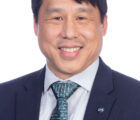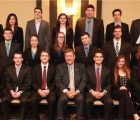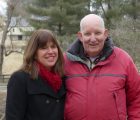
Editor’s note: An earlier version of the following was posted by the author on LinkedIn on August 1, 2018.
An actuary, a doctor, a lawyer, a teacher and a preacher walk into a bar. The lawyer passes the bar, the preacher takes the cup, the teacher tests a few items and the doctor gives out several shots. The bartender then looks at the actuary and says, “What do you do?”
Despite once ranking higher among “top jobs” than the other more well-known professions at the bar, the actuary struggles to answer the bartender’s question with confidence or clarity. Teachers teach, preachers preach, doctors heal and lawyers litigate. Actuaries use mathematics and common sense to ensure there is money in the bank to bring people hope during difficult times, but how does one condense that calling into a succinct summary that, well, “actuates”? [According to Dictionary.com, the verb to actuate is “to incite or move to action; impel; motivate” and “to put into action; start a process; turn on.”]
As it happens, the professions represented at the bar counter have followed sinusoidal cycles of crisis and rebirth that have helped teach their members exactly who they are. And briefly comparing the others’ journeys to the actuary’s may help the latter develop a more meaningful answer to the barkeeper’s deceptively simple icebreaker. We will exempt the preacher from our meditation due to his or her categorically different calling, but the other professions have all generally walked similar paths looking something like the following (events are not presented in strictly chronological order):
- Genesis — Basic human problems such as pain (doctor), accusation (lawyer), confusion (teacher) and thirst (bartender) motivate individuals to find or become solutions. The actuarial profession was actuated, in part, by a need for protection and trust in the ashes of insurance company failures.3
- Identity — Problem solvers develop systems and ideals to guide themselves and future generations. These constructs may be simple, such as an oath to “Do No Harm,” or complex, such as a code of common-law evolving out of centuries of legal practice. They may be wide reaching, such as actuarial standards, or hyperlocal, such as a master practitioner teaching an apprentice.
- Crisis — Overreach and experimentation sometimes create rather than solve problems. Lawyers may win ruinous decisions, questionable surgeries may be miscast as cures for societal challenges, education may produce leeching lifelong customers and excessive faith may be placed in actuarial models. Perhaps less frequently, shocks may be exogenously imposed, for example, Prohibition.4, 5, 6, 7
- Rebirth — Saviors often emerge in unlikely places. A fictional small town lawyer may impact generations of scholars, a mild-mannered TV host may teach simple kindness, anonymous battlefield doctors and nurses may turn necessity into invention and a cat modeling paper may remind actuaries of forgotten exposure posing threats not unlike those that originally yielded the profession.8, 9, 10, 11 The noblest of professions almost unfailingly return to their promised land.
Given the above similarities to his or her bar mates, why doesn’t the actuary simply answer the bartender, “I provide protection and trust”? The reason may relate to a modern-day crisis, of sorts, affecting many disciplines. The emergence of big data has arguably coincided with a measurement obsession in how different professions are conducted and evaluated. If data are available to measure and predict, the thinking goes, so must we (relevance is sometimes optional). And we have thus seen several types of analyses affect how doctors, teachers, and lawyers practice (e.g., short-term survival rates in medicine, standardized test scores in education, and genetic sequences in legal proceedings), but it is certainly debatable how many of these have led to effective intervention.12, 13, 14 Yet presumably few individuals in the affected professions have ceased to view their respective callings as healing, teaching and litigating.
This leads us to the two professions at the bar whose identities have arguably been most and least affected by big data’s emergence. In part because actuaries rely heavily on measurement techniques, their identity has weathered a great deal of introspection due to big data. Other professions with similar skills have usurped actuaries in job rankings, and actuaries have agonized over how much of what they do could be replaced by machines or statisticians — and how they should change as a result. 15, 16, 17 Meanwhile, bartenders as a whole have arguably experienced less tumult than other professions, and their one true crisis was only the result of a temporary public policy. Today robots may be able to mix drinks, but mixologists can be confident that a robot will be unlikely to know the perfect concoction, or question to ask, for five random individuals who walk into a bar.18 Why feel insecure?
In the introduction we noted “actuaries use mathematics and common sense.” Big data has arguably inclined the profession much more in the former direction, but the latter distinctive is arguably equally if not more critical to achieving impact. For example, actuaries’ successes with cat models have not simply been affected with advanced simulation, but by identifying relevant data and implementing learnings in ways that foment protection and trust, which, as we noted, is the basic problem actuaries solve. And, it is said by a true actuarial Survivor contestant, actuaries can find opportunity in any risk simply by “believing in yourself and your profession.”19 Consummate professionals should engage in continuous pursuit of the most appropriate tools and methods, but if they begin to forget who they are and what they do, they risk being forgotten by others.
Acknowledgment: Cheers to the ingenious Su Wash of ISO who helped me brew many of the ideas in this post.
Jim Weiss, FCAS, is an actuary at Crum & Forster and an AR copy editor.
1 “History of Actuarial Profession,” scribd.com/document/70357584/History-of-Actuarial-Profession
2 Casey C. Sullivan, Esq., “13 Worst Supreme Court Decisions of All Time,” blogs.findlaw.com/supreme_court/2015/10/13-worst-supreme-court-decisions-of-all-time.html
3 Hugh Levinson, “The strange and curious history of lobotomy,” BBC News, 8 November 2011, bbc.com/news/magazine-15629160
4 Felix Salmon, “Recipe for Disaster: The Formula That Killed Wall Street,” Wired, February 23, 2009, wired.com/2009/02/wp-quant/
5 “Prohibition’s Effect on Modern Mixology,” The Straight Up, January 16, 2013, drinkstraightup.com/2013/01/16/prohibitions-effect-on-modern-mixology/
6 Diane Roberts, “Atticus Finch: A Hero Who Lost the Battle,” NPR, npr.org/templates/story/story.php?storyId=128443468
7 Richard Gunderman, “Why Mister Rogers’ message of love and kindness is good for your health,” June 8, 2018, The Conversation, theconversation.com/why-mister-rogers-message-of-love-and-kindness-is-good-for-your-health-97970
8 Gali Halevi, “Military medicine and its impact on civilian life,” September 2013, researchtrends.com/issue-34-september-2013/military-medicine-and-its-impact-on-civilian-life/
9 “Karen Clark: Model Citizen,” Property Casualty 360, June 25, 2012, propertycasualty360.com/2012/06/25/6-karen-clark-model-citizen/?slreturn=20180923151713
10 “An Expert Called Lindy,” medium.com/incerto/an-expert-called-lindy-fdb30f146eaf
11 “Standardized Testing Is Not a Fair, Sensible System for Evaluating Teachers,” forbes.com/sites/petergreene/2018/07/26/before-we-evaluate-teachers/#70fd0c191c86
12 “How the Golden State Killer and a genealogy database spawned a golden era in cracking cold cases,” mercurynews.com/2018/07/28/genealogy-database-that-nabbed-golden-state-killer-ushers-in-golden-era-of-cold-case-solving/
13 “The 50 Best Jobs in America — And How Much They Pay,” time.com/money/5114734/the-50-best-jobs-in-america-and-how-much-they-pay/
14 “The Rise of the Machine & the Impact for Actuarial Modelling,” actuarialpost.co.uk/article/the-rise-of-the-machine-the-impact-for-actuarial-modelling-8587.htm
15 “Data Scientist vs Actuary,” actuarialpost.co.uk/article/data-scientist-vs-actuary-9677.htm
16 “In Las Vegas, these bartenders are complete robots, and that’s the fun of this new bar,” latimes.com/travel/la-tr-vegas-tipsy-robot-bar-20170704-story.html
17 “Breaking the Mold,” The Actuary, October/November 2016, theactuarymagazine.org/breaking-the-mold/











